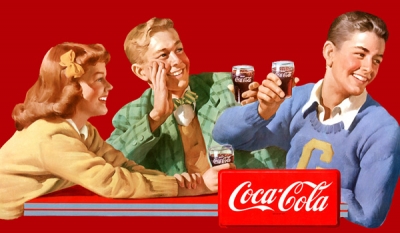The marketing mindset of the world’s largest soft drinks maker is changing.
Spurred by a new CMO and the swelling need to sweat marketing harder, Coke is worried the lingering untruths about the tastes of its drinks could curtail efforts to generate more than 50 per cent of cola sales in Great Britain from lower and no calorie by 2020.
“We haven’t communicated the tastes of our drinks that well and as a result people aren’t making informed choices,” Coke’s GB marketing director Bobby Brittain told.
For instance, five out of 10 consumers do not realise Coca-Cola Zero is a no sugar, no calorie drink.
Less is more - (Image 1)
Less is more is key to a transformation that will spread from Great Britain, Coke’s flagship European market, to its North West Europe, Nordics and Iberia regions from May.
The thirty-year model that dates back to the birth of Diet Coke is gone, meaning each product innovation will no longer be treated as a new brand with separate ideas and personality and branding.
Coke’s conclusion after all those years was that the investment it has been pouring into those separate brands has been getting in the way of what’s actually in the product.
The stripped back approach is built on three pillars that will balance everything the Coca-Cola brand is famous for with the core product benefits of each drink.
This tiered approach will see ads focus on the emotional qualities of the masterbrand at peak times in the year, creative where the drinks are lined up next to each other and their differences highlighted as well as product-focused messages that trumpet the taste of a specific drink.
All marketing under the “One brand” plan will sport a logo of the four contour bottles and the “Choose Happiness” strapline, an update of the company’s long-running “Open Happiness” mantra.
“Open Happiness” is very much entwined with Coca-Cola red and so the business needed something dinstinctive to rally all its drinks around in a way that could also feed its wider global strategies if needed.
Brittain said: “We know that if we make people more aware of the choices that are available to them and exactly what’s in all of those choices then there’s not doubt that they will buy more.”
His comments are an admission that the business could no longer pump funds into promoting the smaller brands when people did not understand what they were when it came to taste.
Instead, it hopes to use the halo-effect of the Coca-Cola masterbrand to bring greater clarity to its product messages.
“This is in our own self-interest that we’re doing this because we’re convinced that there is more growth to get from the segment,” Brittain added.
“But it is also in the interest of our customers because when we do this right there will be additional interest, involvement and excitement in a segment that has shown modest growth.”
Coke is mindful how the seismic changes to its marketing will be greeted by customers, so much so that it is staggering Diet Coke’s introduction to the mix.
The drink’s packaging will be revamped just as the other three have but it will continue to appear in its own newly launched “Regret Nothing” campaign.
Diet Coke: The best of both worlds - (Image 2)
Diet Coke will get the “best of both worlds,” assured Brittain, mindful of the ramifications of playing “fast and loose” with a product that represents a quarter of the business.
To that end, the drink’s transition to the “One brand” strategy will be slow and more calculated with Coke conducting regular customer research panels in order to gauge the right time to fully transfer it over.
“There are about a million reasons why we’re taking our time with Diet Coke and that’s the millions of people for whom the drink is a part of their lives.
It has its own identity and it has its own personality and so it’s going to benefit from both the “Regret Nothing” and “Choose Happiness” campaigns.
A new formula for sponsorships and partnerships - (Image 3)
From James Bond to Marc Jacobs, the World Cup to the London Eye, Coke has storied heritage when it comes to lending its brand to others.
And this isn’t going to change under the new strategy though it will see events like this year’s Rugby World Cup used to spotlight a specific drink, which will be Coca-Cola Zero.
The fastest growing brand in the cola portfolio will push its zero calorie message around the tournament in a sponsorship campaign that Brittain said would give the brand “it’s fair share of air time”.
One early proof of concept creative shows all four contour bottles lifting the black Coca-Cola Zero bottle in the air as it were a lighthouse.
“The intention is to continue these partnerships,” he added. “But the way that we then execute those will change and it will be much more Coca-Cola led and we will choose to make one product more prominent than the others.”
Lessons Learned - (Image 4)
The scope of the “One brand” strategy across Europe is emblematic of the marketing wrongs the business is trying to right.
Coke’s marketing bore the brunt of the blame for lacklustre sales in 2014 that led to a renewed push for more effective media.
In Great Britain, the business has had the luxury of insights from its hugely popular “Share a Coke” and sales boosting Christmas festive foray to guide investments over the next 12 months.
Both efforts brought personilsaiton to the fore and it is the connected theme of choice that Brittain believes is the most salient learning.
“At its core the ‘One brand’ strategy is about choice for the consumer,” he added.
“Other learnings we’ve taken come particularly from the digital space with our ecommerce approach [around ‘Share a Coke’] and the way that we did social media.
That digital aspect will remain front and centre of not only the launch campaign but the new business model moving forward.”
Cheaper, more targeted media is de rigueur for marketers looking to weed out ineffective spend amid pressure from the top to rein in costs.
Brittain acknowledged these challenges and said its learnings had shaped the company’s search for “effectiveness not efficiency” when it comes to its campaign planning.
“When people drink Coca-Cola Zero it has be because they truly understand that there are no calories in it. And so the effectiveness of our communication has to be improved,” said Brittain.
A numbers game - (Image 5)
The ultimate test for Coke’s new marketing plan will be whether it can put the fizz back into sales in Great Britain.
Value sales across the whole Coca-Cola portfolio, which includes Diet Coke Caffeine Free Cola, dipped one per cent to £1.2bn in the 52 weeks to January, buoyed by a strong turnout for Coca-Cola Zero, according to the latest IRI data.
This is in comparison to the 106 per cent uplift in value sales for all Pepsi cola brands to £844m in the period, albeit from a smaller distribution base.
Brittain said: “We’re not getting as much growth as we could given there’s this fundamental lack of understanding about what’s going into these products.
We’re in segment that has shown modest growth in the low singled digits and believe there middle to high digital growth to get.
“This is about writing the next chapter in an incredible [marketing] story that started 129 years ago and come through the 70s hilltop celebration to more recently the work we’ve done around Christmas."
The revamped packaging for the drinks will ht shelves later this month ahead of nationwide push in May.























